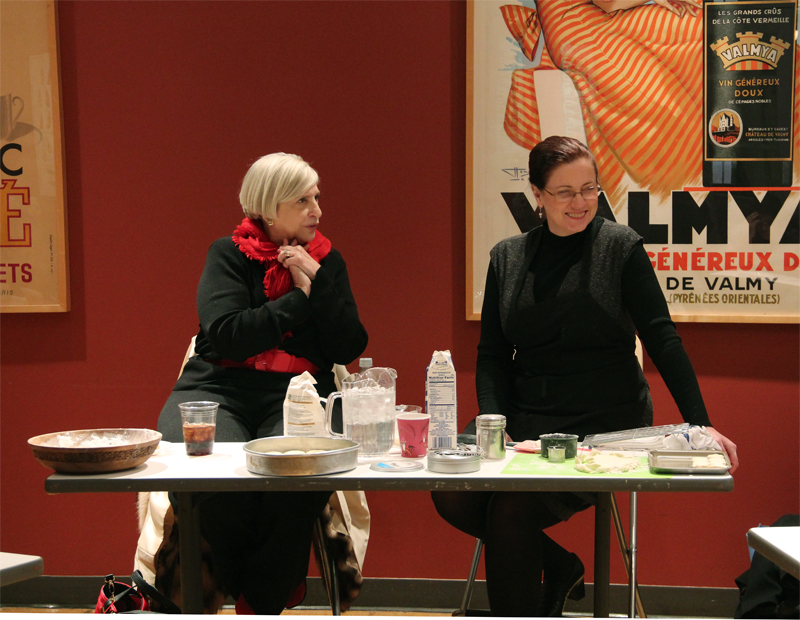Renown chefs Nathalie Dupree and Cynthia Graubart know a thing or two about southern cuisine. In Dupree's 40-year career, she has authored twelve cookbooks (for which she won two James Beard Awards) and hosted over 300 culinary television shows. Graubart was the television producer for Dupree's New Southern Cooking and went on to pen two of her own cookbooks before the pair joined forces as writers.
With the 2012 release of the 720-page Mastering the Art of Southern Cooking, these dynamic chefs have yet again demonstrated their expertise, publishing the most comprehensive text on the region's culinary traditions since Mrs. S.R. Dull's Southern Cooking (1928).

This week, Dupree and Graubart joined the ICE community to discuss "Real Southern Cooking" and to share their top tips for regional culinary staples. To begin, Dupree described the diverse ethnic communities - from Italian to Jewish, Chinese and African -that shaped what we today call "southern" cuisine. "All food in America is fusion food," Dupree explained, pointing to the much-lauded Carolina Gold rice that originated from grains transported by international trade. That said, there are certain dishes that Dupree disclaimed as inauthentically southernmost notably, peach pie and fried chicken and waffles. One regional delicacy both chefs heartily approve of is the biscuit, on which they previously penned an exhaustive guide, Southern Biscuits (2011). Their essential tips for the perfect biscuit:
- First and foremost, do a toast test. No one's oven is perfect, and you can evaluate the way yours works by watching the toasting patterns of a sheet pan of white bread in a very hot oven. This will help you know where to place and when you will need to rotate the items you bake.
- Use a soft wheat flour, like White Lily. You can order it online, or it may be sold at Balducci's or Fairway in New York City.
- It's important to mix the dough in a low, wide bowl, so as not to overdevelop the gluten in the flour.
- No recipe that includes flour is exact, so adapt ratios as necessary to achieve the desired consistency.
- Most beginners ruin their biscuits by adding too much flour. The dough should stick to your fingers and remain very pliable.
- Don't knead the dough. Pat it into a mound and then fold it. If using a plastic cutting mat, you can fold the mat itself to maneuver the dough, creating creases that will flake when baked.
- When cutting biscuits, do not twist the cutter. Simply press down and lift up.
- When baking biscuits, crowd the pan to achieve a more tender, moister biscuit.

Ingredients
- 2 1/4 cups self-rising flour
- 1 1/4 cups heavy cream
- Butter, softened or melted, for finishing
Directions
- Preheat the oven to 450 degrees. Select a larger baking pan for crispier biscuits, or a smaller pan for more tender biscuits. (Whether or not air can circulate around the biscuits determines their texture. Graubart and Dupree prefer small cake or loaf pans.)
- Fork-sift or whisk 2 cups of flour in a large bowl, and set aside the 1/4 cup. Make a deep hollow in the center of the flour with the back of your hand. Pour 1 cup of cream, reserving 1/4 cup cream into the hollow, and stir with a rubber spatula or large metal spoon, using broad circular strokes to quickly pull the flour into the cream.
- Mix until the dry ingredients are moistened and the sticky dough begins to pull away from the sides of the bowl. If there is some flour remaining on the bottom and sides of the bowl, stir in 1-4 tbsp of reserved cream, just enough to incorporate the remaining flour into the shaggy, wettish dough. Or, if the dough is too wet, add additional flour when shaping.
- Lightly sprinkle a plastic cutting mat with some of the reserved flour. Turn the dough onto the mat and lightly sprinkle the top with more reserved flour. With floured hands (or using the flexible mat), fold the dough in half and pat it into a 1/3- to 1/2-inch-thick round, using only a little additional flour as needed. Continue folding and flouring (only as necessary) 1-2 more times.
- Pat dough into a 1/2-inch-thick round for a normal biscuit, 3/4-inch-thick round for a tall biscuit or a 1-inch-thick round for a giant biscuit. Brush off any visible flour from the top. To cut biscuits, dip the 2-inch biscuit cutter into the reserved flour, and press into the outside edge of the round, cutting very close together. The scraps may be combined to make additional biscuits, although they will be tougher than the original batch.
- Move the biscuits to the pan or baking sheet. Bake on the top rack of the oven for 10-14 minutes until light golden brown. After 6 minutes, rotate the pan and check to see if the bottoms are browning too quickly. If so, slide another baking pan underneath to add insulation and slow browning. Continue baking another 4-8 minute until light golden brown. When biscuits are done, remove from oven and lightly brush with the butter. Turn the biscuits upside down on a plate to cool slightly. Serve hot, right-side-up.



